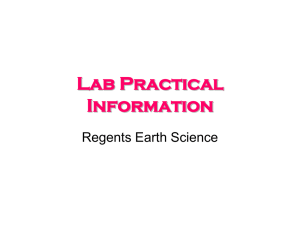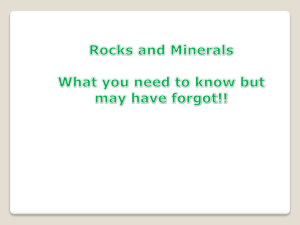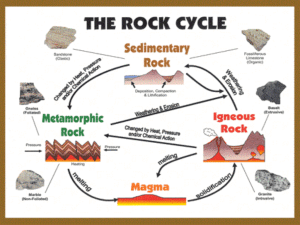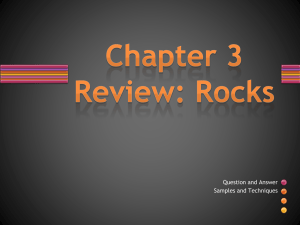Rocks and Minerals
advertisement
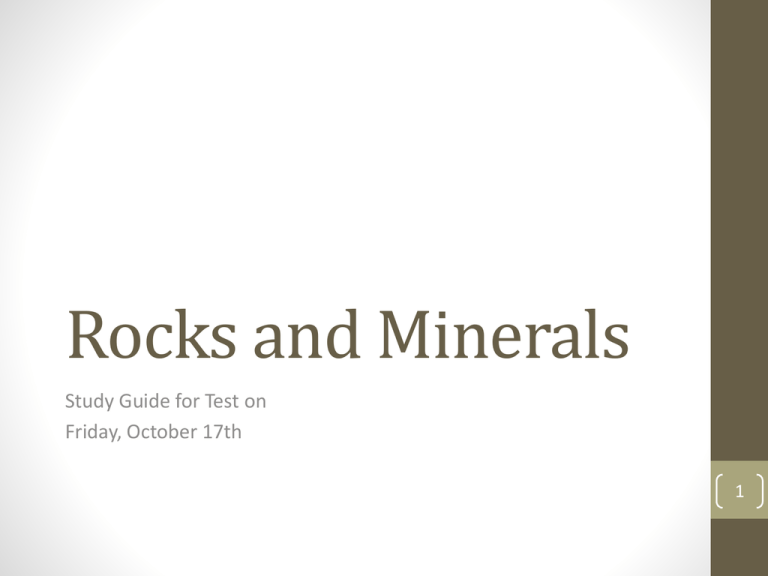
Rocks and Minerals Study Guide for Test on Friday, October 17th 1 Continental Drift •Remember that Wegener’s Theory of Continental Drift states that the continents were once joined together as a super-continent called Pangaea. 2 • Besides the puzzle-like fit of the continents, the best evidence for his theory includes similar types of rocks and fossils, the remains of a plant or animal that have been cast in rock. 3 Minerals Minerals are: • Naturally occurring • Inorganic (nonliving) • Solid • Things that have a definite composition and crystalline structure 4 “Geology Kitchen” http://www.youtube.om/watch?v=rTXSwnkieZc Example: 6 You try! • • • • • SALT Solid Crystal Structure Inorganic Vs. SUGAR Solid Crystal Structure Organic (comes from something living) All Minerals Definite Chemical Composition Naturally Occurring Made by nature not by man Inorganic NOT made from once-living materials are/have Solid Not a liquid or a gas; particles packed so tight they can’t move Always has certain elements Crystal Structure Repeated pattern of atoms Answer: • Salt is the mineral. It meets all the requirements in the definitions of mineral. • Sugar is NOT a mineral. It does not meet one of the requirements to be a mineral. Sugar is organic because it comes from a plant. Minerals are identified by using their properties: •Color •Luster – the way in which a mineral reflects light 10 • Streak – the color of the powder of a mineral • Cleavage – the splitting of a mineral along smooth, flat surfaces • Fracture – the manner in which a mineral breaks along either curved or regular surfaces 11 •Hardness – a measure of the ability of a mineral to resist scratching; Diamond is the hardest mineral; Talc is the softest mineral 12 Mohs Hardness Scale: • Measures the hardness of minerals & orders them so you can see which mineral scratches other minerals. Use the Mohs Hardness Scale on page 72 to answer the following questions: 1. Would a piece of Apatite scratch a piece of Quartz? 2. What would you expect to happen if you rubbed a mineral of hardness 8.5 against a piece of Topaz? 3. Which mineral in the Scale will scratch quartz? 4. List the following minerals in order of decreasing hardness: apatite, fluorite, diamond, talc, and gypsum. Answers: 1) No 2) The Topaz would scratch. 3) Topaz, Corundum, Diamond 4) Diamond, Apatite, Flourite, Gypsum, Talc •Density – the ratio of the mass of a substance to the volume of a substance; “how much stuff is packed into a certain amount of space” 16 • Graphite is used to make pencil lead. Minerals Jam http://www.youtube.com/watch?v=F0IA21bgmM 17 Color Identify Minerals Magnetic, fluorescent, reactive Streak The color of its powder Cleavage and Fracture by Fracture – minerals break irregular Luster Way a surface reflects light Shiny, glassy, waxy, pearly Special Properties Density mass in a given space Hardness Cleavage – mineral splits along flat surfaces Crystal Systems How hard or soft 6 groups of crystal shapes Rocks • The most useful way to identify a rock is by its mineral content. Different colors in rocks are due to the different minerals in them. 19 • Rocks are classified by how they are formed, and there are three types of rocks – sedimentary, igneous, and metamorphic. One type of rock can be changed into another by undergoing the rock cycle. When old rock is changed into new rock during the cycle, it takes a very LONG time. Not all rocks go through the entire cycle. 20 21 22 23 Rock Cycle Clip http://www.youtube.com/watch?v=pm6cCg_Do6k 24 Sedimentary Rocks • Sedimentary rocks are formed by weathering (when wind, water, and ice break down rocks into sediment), erosion (when soil and sediment is moved from one place to another), and deposition (the process in which material is laid down). 25 • Layers of sediment are pressed and cemented together to form sedimentary rock. Most fossils are found in sedimentary rock. • Sandstone is an example of a sedimentary rock. 26 Sedimentary Rocks form in areas of deposition. 27 See how individual pieces of sediment and sand have stacked on top of each other and pressed down so tightly it hardened into a solid rock. 29 Sedimentary Rock Animation • Interactives . The Rock Cycle . How Rocks Change Igneous Rocks • Igneous rock forms when hot, liquid rock, or magma, cools and solidifies. (Magma is formed underground, but it is called lava when it reaches the surface.) Volcanos are associated with igneous rocks. 31 Intrusive vs. Extrusive Rock • Intrusive igneous rock is formed beneath the Earth’s surface. Because of the slow cooling time, large crystals are formed. • Extrusive igneous rock is formed on the Earth’s surface, and since it cools quickly, very small or no crystals are formed. 32 Intrusive igneous rocks have time to form large crystals. Granite An underground cave in Mexicomagma cooled very slowly- lots of time for crystals to form. Mount Rushmore is carved from granite in the Black Hills of South Dakota. Stone Mountain is made of Granite, an igneous rock. Extrusive Igneous Rocks Cool quickly on the outside of the volcano- little or no crystals! Animation of 2 Types of Igneous Rocks • Interactives . The Rock Cycle . How Rocks Change Metamorphic Rocks • Metamorphic rocks are rocks in which the structure, texture, or composition have changed. Metamorphic rocks are formed by extreme heat and pressure. 38 39 40 41 • Marble is an example of a metamorphic rock. 42 Animations • Observe an animation of metamorphic rocks forming. • Interactives . The Rock Cycle . How Rocks Change Rock Cycle Rap and Song http://www.youtube.com/watch?v=rkGVE6wNAzo http://www.youtube.com/watch?v=lE3jR_RhxO4 44 Rock Cycle Song (Sing to the tune of "Row, Row, Row Your Boat") SEDIMENTARY rock Has been formed in layers Often found near water sources With fossils from decayers. Then there's IGNEOUS rock Here since Earth was born Molten Lava, cooled and hardened That's how it is formed. These two types of rocks Can also be transformed With pressure, heat and chemicals METAMORPHIC they'll become. 45 “We Will Rock You” http://www.youtube.com/watch?v=hAMBkoLhTBY 46 Fossils • Studying fossils helps us learn how the Earth’s environment has been changed. In large sections of sedimentary rock, the oldest fossils will be found in the bottom layer. 47 • Sometimes fossils from ocean animals are found on tops of mountains! That means that the mountain was once covered by the ocean a very long time ago and the mountain was raised up due to the movement of lithospheric plates. 48 Fossil Fuels • Fossil fuels can be obtained by surface mining, strip mining (removing long strips of overlying soil and rock), and drilling wells. • The energy found in fossil fuels originally came from the Sun. 49 • Petroleum and natural gas form mainly from decayed sea organisms. • Smog is the photochemical base formed when sunlight acts on industrial pollutants and burning fuels. 50
